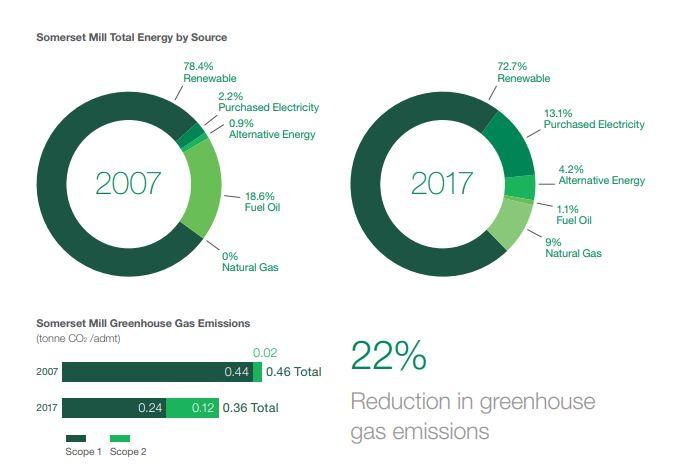Sappi Reduced Greenhouse Gas Emissions by 22% in 2017

In terms of total consumption of energy, pulp and paper is third among industrial sectors; only the refi ning and chemical industries consume more. However, environmental impact is affected not just by the amount of energy consumed, but also by the type of energy. On average, US pulp and paper mills derive nearly two-thirds of their energy needs from renewable sources that are considered carbon neutral. Sappi’s mills derive nearly 80 percent of their energy from renewable resources.
Across the organization, we have strategically reduced our use of traditional fossil fuels by seeking out alternative energy sources, including reclaimed oil, construction and demolition wood, and tirederived fuel. Simultaneously, we have increased our usage of traditional biomass sources from woody biomass and black liquor. The cumulative effect results in higher levels of renewable energy, lower greenhouse gas emissions and reduced energy costs.
The results at our Somerset Mill exemplify our commitment to continuous improvement and cost containment. Looking back, in 2007 the mill generated 18.6 percent of its energy from fuel oil. Over the past ten years the mill has successfully executed a series of energy improvement projects. Many of these projects have been a result of upgrading equipment, from more effi cient lighting and motors, to waste heat recovery. In 2010 the mill invested heavily in the utilities complex, upgrading the chemical recovery boiler and evaporator system. And in 2013 we announced an agreement with Summit Natural Gas of Maine to establish natural gas service to the Somerset Mill. This massive infrastructure project also brought natural gas to seventeen local communities.
The ongoing focus on both energy use and energy type has dramatically shifted the energy profi le at the Somerset Mill. It currently purchases more energy from the electric grid (increasing Scope 2 emissions), but, more signifi cantly, only 1.2 percent of the energy was derived from fuel oil. Displacing fuel oil with natural gas reduces the mill’s output of greenhouse gas emissions because CO2 emissions from natural gas are 30 percent lower than #6 fuel oil, based on equivalent energy input. The net result has been a 22 percent reduction in combined Scope 1 and Scope 2 greenhouse gas emissions.
Read more from Sappi North America's 2017 Sustainability Report here: http://bit.ly/Sappi-SR17

